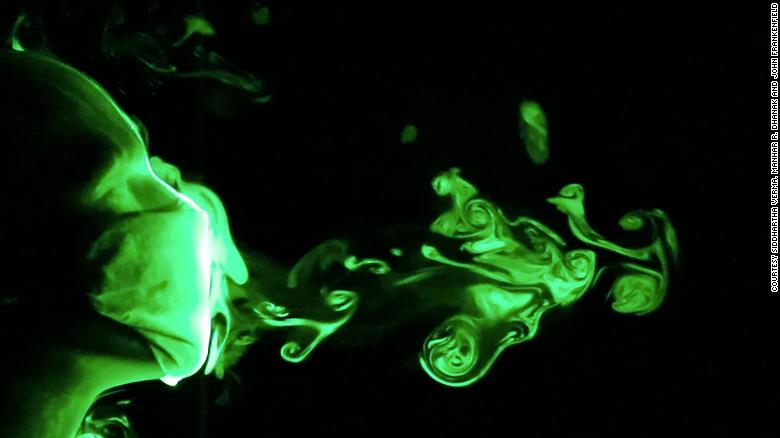Pathways of spread of covid-19 0:42
(CNN Spanish) -
Scientists worldwide have proven that the coronavirus can be transmitted by aerosols, that is, by air.
Researchers recently published in the medical journal The Lancet 10 reasons why the international community should accept this as fact.
Dr. Elmer Huerta explains each of these arguments to us in this episode.
You can listen to this episode on Spotify or your favorite podcast platform or read the transcript below.
Hello, I am Dr. Elmer Huerta and this is your daily dose of information on the new coronavirus.
Information that we hope will be useful to take care of your health and that of your family.
Today we will hear a summary of a comment letter that American and British scientists publish online in The Lancet of April 15, in which they argue the reasons why, definitely, science, politicians, and the general public They must accept that SARS-CoV-2 is spread through the air, through microscopic aerosols released by infected people through their breath.
advertising
The coronavirus is spread through the air
During the first months of the pandemic, there was a lot of uncertainty regarding the mode of contagion of the new coronavirus.
Thinking that the mode of contagion was like that of the flu, through thick droplets of secretions released when coughing or sneezing, at first it was advised that only people with symptoms wear masks.
In those early days, it was also thought that contagion could be very effective when touching contaminated surfaces, and complete disinfection of surfaces, including everyday clothing and even shoes, was advised.
But during those first days, there were already voices that were raised in the scientific community, that the contagion of covid-19 could be produced simply by breath, through aerosols.
In the April 6, 2020 episode, for example, we described that in a letter dated April 1 of last year, the National Academies of Sciences, Engineering and Medicine of the United States - the most important and prestigious nonpartisan scientific organization the country - responded to a question from the White House, that "although current studies are inconclusive, the results of available studies are consistent with aerosolization of the virus by normal respiration."
What is coronavirus aerosolization?
In simple terms, that meant that the virus could be in the invisible aerosol that is produced during normal breathing, and therefore it was possible that a person could spread the virus through breathing.
This finding was undoubtedly very disturbing, and it was the basis that allowed the Centers for Disease Control and Prevention (CDC) to change its recommendation, suggesting that everyone - healthy or healthy. sick - must have worn a mask in public, specifying that the mask can be made of regular cloth.
Unfortunately, the concept of aerosols being the main route of infection has not been quickly and universally accepted.
Many scientists, including the World Health Organization, do not accept this vital concept, which makes prevention recommendations more aimed at preventing transmission from thick drops than from aerosols.
What the scientists say
For example, the comment published in The Lancet says that accepting that aerosols are the main route of infection, would make preventive measures focus on reducing the transmission of viruses through the air, and for that, the main recommendations would be focused on:
Ventilation,
Air filtration,
Reducing overcrowding and time spent indoors;
The mandatory use of masks in all enclosed spaces;
Pay attention to quality
And mask-fit and higher-grade protection for healthcare workers and front-line workers.
Unfortunately, not accepting that the virus is transmitted by air through aerosols makes the current recommendations focus on preventing the spread by thick droplets, placing emphasis on reducing direct contact, cleaning surfaces, installing physical barriers in environments, physical distancing , use of masks only when close to other people, and use of high-grade protection only in those so-called aerosol-generating sanitary procedures, such as in dentists' offices for example.
Ten Reasons We Know You Can Get Covid-19 Through the Air
The comment continues, listing 10 reasons why it should be accepted that aerosols are the main way of contagion of COVID-19.
First:
Numerous super-spreading events of the virus have been investigated, showing that the type of massive contagion that occurred in these events cannot be explained simply by contagion from thick droplets or contaminated surfaces.
This super-spread of the virus can only be explained by airborne transmission of aerosols.
Second:
It has been shown that the contagion produced between hotel rooms, in which the infected people did not have direct contact with each other, can only be explained by aerosols.
Third:
Knowing that a person can spread just by talking, and that asymptomatic or presymptomatic people are capable of spreading, the possible number of infections is very large, calculating at least a third, and perhaps up to 59%, according to the article in The Lancet.
Bedroom:
The contagion occurs mainly in closed spaces, and it is very rare that it occurs in open spaces.
It is essential to know that the ventilation of a closed space greatly reduces the possibility of contagion.
Fifth:
Infections have been demonstrated in hospitals where all precautions were taken to avoid contagion by thick droplet secretions, but not to avoid contagion by aerosols.
Sixth:
In experiments carried out in the rooms of infected people and even in their vehicles, viable viral particles have been isolated.
This indicates that the aerosols can remain suspended in the air for a variable time that, depending on the ventilation of the room, can be hours.
Seventh:
The virus has been isolated in air filters and ventilation ducts in hospitals, places that obviously cannot be reached by thick droplets, but only by aerosols.
Eighth:
Infections of the virus have been demonstrated in caged and separated laboratory animals, whose cages were only communicated through tubes, infections explained only by the transmission of aerosols, not by thick droplets.
Nineth:
So far there is no study that has refuted the hypothesis that contagion is by aerosols.
The contagion is dependent on variables such as the viral load of the infected person, the ventilation of the space and the number of people in the room.
Tenth:
In the same way that there is no study that has refuted the hypothesis that contagion is by aerosols, the evidence is limited to support that the spread is through other dominant forms of transmission.
Furthermore, the number of viral particles can be higher in aerosols than in large droplets.
Thinking that contagion occurs only when people are close by, through thick drops, has become - say the scientists who write the commentary - a dogma that is very difficult to change.
The conclusions
The spread of SARS-CoV-2 occurs predominantly by aerosol transmission.
Our daily activities should be aimed at reducing the probability of contagion by aerosols:
Using double mask,
Avoiding agglomerations in closed spaces without ventilation for more than 15 minutes,
Avoiding sharing closed spaces with people who do not live in the same home
And ventilating transport vehicles and rooms, especially in those where infected people are or were.
Do you have questions about the coronavirus?
Send me your questions on Twitter, we will try to answer them in our next episodes.
You can find me at @DrHuerta.
If you think this podcast is useful, help others find it by rating it on your favorite podcast app.
We'll be back tomorrow so be sure to subscribe to get the latest episode on your account.
And for the most up-to-date information you can always head to CNNEspanol.com.
Thanks for your attention.
If you have any questions you can send them to Dr. Elmer Huerta through Twitter. You can also head over to CNNE.com/coronaviruspodcast for all episodes of our “Coronavirus: Reality vs. Reality” podcast. fiction".
coronavirusCovid-19





